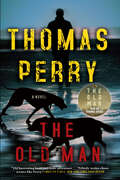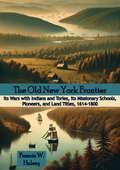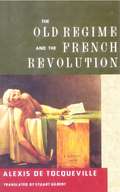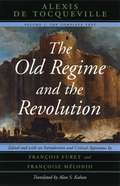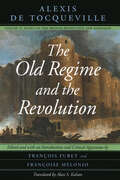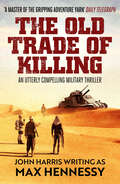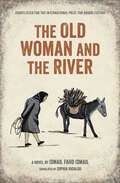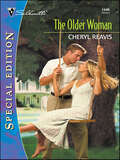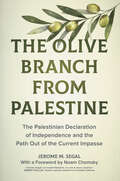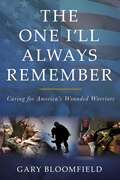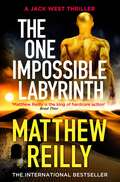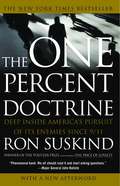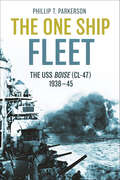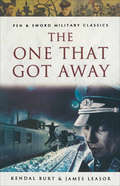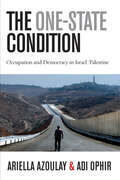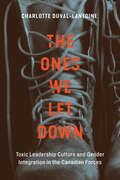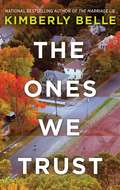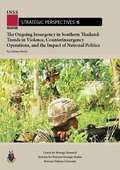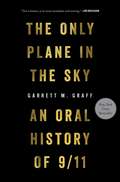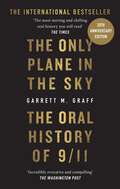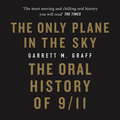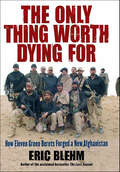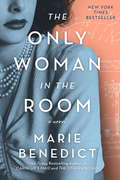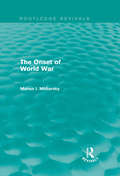- Table View
- List View
The Old Man
by Thomas PerryNow an original series from FX starring Jeff Bridges, John Lithgow, and Amy Brenneman: a retired intelligence officer living off the grid is caught in &“[a] harrowing hunt-and-hide adventure&” (The New York Times). To all appearances, Dan Chase is a harmless retiree in Vermont with two big mutts and a grown daughter he keeps in touch with by phone. But most sixty-year-old widowers don&’t have multiple driver&’s licenses, savings stockpiled in banks across the country, or two Beretta Nanos stashed in the spare bedroom closet. Most have not spent decades on the run. Thirty-five years ago, as a young army intelligence hotshot, Chase was sent to Libya to covertly assist a rebel army. When the plan turned sour, Chase acted according to his conscience—and triggered consequences he never could have anticipated. To this day, someone still wants him dead. And just when he thought he was finally safe, Chase is confronted with the history he spent much of his life trying to escape. Edgar Award–winning author Thomas Perry writes thrillers that move &“almost faster than a speeding bullet&” (Wall Street Journal). The Old Man is his latest whip-smart standalone novel, and has been adapted into a critically acclaimed television series starring Jeff Bridges as retired CIA Agent Dan Chase. &“Perry drives deep into Jack Reacher territory in this stand-alone [novel] . . . Swift, unsentimental, and deeply satisfying.&” —Kirkus Reviews
The Old New York Frontier: its Missionary Schools, Pioneers, and Land Titles, 1614-1800
by Francis W. HalseyFrancis W. Halsey’s The Old New York Frontier offers a compelling exploration of the rich and turbulent history of New York's frontier region between 1614 and 1800. Through vivid detail and thorough research, Halsey chronicles the dramatic events and key figures that shaped this pivotal area during a period of intense conflict and transformation.The book delves into the complex relationships between Native American tribes, European settlers, and British loyalists (Tories), shedding light on the wars, treaties, and alliances that defined the region’s early history. Halsey also examines the role of missionary schools in attempting to bridge cultural divides, the challenges faced by pioneering settlers, and the contentious land disputes that arose as communities expanded.Against the backdrop of the Revolutionary War and the broader colonial struggle for independence, The Old New York Frontier captures the hardships and triumphs of a region caught between competing interests and ideologies. Halsey’s meticulous attention to detail and use of historical records make this work an invaluable resource for understanding the complexities of early American life on the frontier.Rich in narrative and historical insight, this book is essential reading for history enthusiasts, particularly those interested in the intersection of Native American, Colonial, and Revolutionary history. It provides a fascinating window into the dynamic forces that shaped one of America’s most historically significant frontiers.
The Old Regime and the French Revolution
by Alexis De Tocqueville Stuart GilbertThe French Revolution is undoubtedly one of the most significant events in world history, one whose repercussions still affect Western society today, two hundred years later.
The Old Regime and the Revolution, Volume I: The Complete Text
by Alexis de TocquevilleThe Old Regime and the Revolution is Alexis de Tocqueville's great meditation on the origins and meanings of the French Revolution. One of the most profound and influential studies of this pivotal event, it remains a relevant and stimulating discussion of the problem of preserving individual and political freedom in the modern world. Alan Kahan's translation provides a faithful, readable rendering of Tocqueville's last masterpiece, and includes notes and variants which reveal Tocqueville's sources and include excerpts from his drafts and revisions. The introduction by France's most eminent scholars of Tocqueville and the French Revolution, Françoise Mélonio and the late François Furet, provides a brilliant analysis of the work.
The Old Regime and the Revolution, Volume II: Notes on the French Revolution and Napoleon
by Alexis de TocquevilleThe continuation of Alexis de Tocqueville’s great meditation on the origins and meanings of the French Revolution. With his monumental work The Old Regime and the Revolution, Alexis de Tocqueville (1805–59)—best known for his classic Democracy in America—envisioned a multivolume philosophical study of the origins of modern France that would examine the implications of French history on the nature and development of democratic society. Volume I, which covered the eighteenth-century background to the Revolution, was published to great acclaim in 1856. On the continuation of this project, he wrote: "When this Revolution has finished its work, [this volume] will show what that work really was, and what the new society which has come from that violent labor is, what the Revolution has taken away and what it has preserved from that old regime against which it was directed." Tocqueville died in the midst of this work. Here in Volume II is all that he had completed, including the chapters he started for a work on Napoleon, notes and analyses he made in the course of researching and writing the first volume, and his notes on his preparation for his continuation. More than ever before, readers will be able to glean how Tocqueville's account of the Revolution would have come out, had he lived to finish it. This handsomely produced volume completes the set and is essential reading for anyone interested in the French Revolution or in Tocqueville’s thought.
The Old Trade of Killing: An utterly compelling military thriller (Shadows of War Collection)
by Max HennessyThe fighting has long since ended. But the conflict is far from over…Twenty years after the Second World War, five tough veterans return to the Sahara in a desperate search for bomb-buried bullion. But twenty years can change a man.Young ideals have been replaced by greed. Comradeship has vanished along with innocence. And treachery and murder are rife among them.This exciting adventure is set against the backdrop of the Western Desert and scene of the Eighth Army battles, in this blistering, scorching read, perfect for fans of David McDine, Hammond Innes and Alistair MacLean.
The Old Woman and the River
by Ismail Fahad IsmailAfter the ceasefire in 1988, the devastation to the landscape of Iraq wrought by the longest war of the twentieth century—the Iran-Iraq War—becomes visible. Eight years of fighting have turned nature upside down, with vast wastelands being left behind. In southeastern Iraq, along the shores of the Shatt al-Arab River, the groves of date palm trees have withered. No longer bearing fruit, their leaves have turned a bright yellow. There, Iraqi forces had blocked the entry points of the river&’s tributaries and streams, preventing water from flowing to the trees and vegetation. Yet, surveying this destruction from the sky, a strip of land bursting with green can be seen. Beginning from the Shatt al-Arab River and reaching to the fringes of the western desert, several kilometers wide, it appears as a lush oasis of some kind. The secret of this fertility, sustaining villages and remaining soldiers, is unclear. But it is said that one old woman is responsible for this lifeline.
The Older Woman
by Cheryl ReavisNO GUTS, NO GLORY...Or so paratrooper Captain Cal Doyle believed. But seduce tough-talking Nurse Katherine Meehan, who’d tended to him after his copter crash? Impossible! True, they were now next-door neighbors-yet they were years apart. And while Kate had survived breast cancer, Cal had barely survived hell....So just because Cal caught Kate crying in the rain...and her fussy feline cozied up to him...and the church ladies started matchmaking...and Kate suddenly looked so damn desirable-were those any reasons for a wounded warrior to woo a reluctant older woman? Besides, between Kate’s stubborn defenses and Cal’s mule-headed machismo, could these two survivors...survive each other?
The Olive Branch from Palestine: The Palestinian Declaration of Independence and the Path Out of the Current Impasse
by Jerome M. SegalIsraeli settlements are proliferating in Palestinian territory, and if they are annexed, the possibility of a future Palestinian state is virtually impossible. Could it have been otherwise? Can it still be? These are the questions Jerome M. Segal poses in The Olive Branch from Palestine. Carefully argued and highly informative, this book is centered on an original strategy that Segal devised—a strategy adopted but only partially implemented by Palestinian leadership, leaving its feasibility untested. The first step of this strategy was the issuance in November 1988 of the Palestinian Declaration of Independence. That document, authored by Palestinian national poet Mahmoud Darwish and modeled on Israel's own Declaration, called for a Palestinian state that would live in peace with Israel. In The Olive Branch from Palestine, Segal provides in the first part an analytical and historical study of the 1988 Declaration, a remarkable act of unilateral peacemaking through which the PLO accepted the legitimacy of the 1947 Partition Resolution and thereby redefined Palestinian nationalism. In the second part, he proposes a new strategy based on solutions to the two core issues of 1948: the preservation of a Jewish state, and the rights and circumstances of Palestinian refugees. With The Olive Branch from Palestine, Jerome Segal offers a new narrative of the peace process and details a Palestinian-led strategy that could end the conflict.
The One I'll Always Remember: Caring for America's Wounded Warriors
by Gary L. BloomfieldThe One I'll Always Remember puts the reader on the front lines and in the operating rooms to experience the dramatic impact on the military care providers who have told their stories. The reader will feel the emotional and psychological trauma of extended combat surgeries, and learn the coping skills, such as avoiding knowing a patient's name or too much personal information, including whether he&’s married or has children. These medical personnel save more than 95 percent of all the wounded warriors who come to the field hospitals, yet it's those few who don't make it which haunt them for years--and sometimes forever. The guilt of not being able to save everyone, and of asking if they could have done more. Not knowing their names, but still seeing their faces in haunting memories, even decades later.
The One Impossible Labyrinth: The Brand New Jack West Thriller (Jack West Series)
by Matthew ReillyTHE BRAND NEW JACK WEST THRILLER'THE HOTTEST ACTION WRITER AROUND' EVENING TELEGRAPHTHE END IS HEREJack West Jr has made it to the Supreme Labyrinth.Now he faces one last race - against multiple rivals, against time, against the collapse of the universe itself - a headlong race that will end at a throne inside the fabled labyrinth.AN IMPOSSIBLE MAZEBut the road will be hard. For this is a maze like no other: a maze of mazes. Uncompromising and complex. Demanding and deadly.A CATACLYSMIC CONCLUSIONIt all comes down to this. It ends here - now - in the most lethal and dangerous place Jack has encountered in all of his many adventures. And in the face of this indescribable peril, with everything on the line, there is only one thing he can do.Attempt the impossible.* * * * *PRAISE FOR THE JACK WEST THRILLERS'An action hero worthy of Lee Child' Sydney Morning Herald'Thrilling, action-packed adventure from cover to cover' Guardian'Nobody writes action like Matthew Reilly' Vince Flynn'Get ready for a wild ride' Daily Telegraph'Exciting and entertaining' Chicago Sun-Times* * * * *READERS LOVE THE JACK WEST THRILLERS'Indiana Jones in a book . . . Immensely entertaining''A super duper kick ass soldier''A first class all-action historical thriller''Heart-pounding stuff''Enjoy the rollercoaster ride'
The One Percent Doctrine: Deep Inside America's Pursuit of Its Enemies Since 9/11
by Ron SuskindPulitzer Prize-winning journalist and bestselling author Ron Suskind takes you deep inside America's real battles with violent, unrelenting terrorists -- a game of kill-or-be-killed, from the Oval Office to the streets of Karachi. You may think you know what the "war on terror" is. But to know it truly, you must read this book. Suskind has written a riveting work of narrative nonfiction, filled with exclusive, historically significant disclosures that will echo across America and the world. What is the guiding principle of the world's most powerful nation as it searches for enemies at home and abroad? The One Percent Doctrine is the deeply secretive core of America's real playbook: a default strategy, designed by Dick Cheney, that separates America from its moorings, and has driven everything -- from war in Afghanistan to war in Iraq to the global search for jihadists. The story begins on September 12, 2001, the day America began to gather itself for a response to the unimaginable. Ultimately, that reply would shape the nation's very character. Suskind tells us what actually occurred over the next three years, from the inside out, by tracing the steps of the key actors -- the notables, from the President and Vice President to George Tenet and Condoleezza Rice, who oversee the "war on terror" and report progress to an anxious nation; and the invisibles, the men and women just below the line of sight, left to improvise plans to defeat a new kind of enemy in an hour-by-hour race against disaster. The internal battles between these two teams -- one, under the hot lights; the other, actually fighting the fight -- reveal everything about what America faces, and what it has done, in this age of terror. Who is actually running U. S. foreign policy? Is there an operational cell, armed with WMDs, inside the United States? Have some of the world's most dangerous terrorists -- including leaders of al Qaeda -- been caught and accidentally released? Can America prevail in this struggle against enemies who are patient, ingenious, certain, and have clear tactical advantage?With his unparalleled access to senior officials, past and present, Ron Suskind -- author of The Price of Loyalty, the most revealing book yet written on the Bush administration -- finally answers the questions that keep Americans awake at night. And in this startling book, he reframes the debates that roil the globe.
The One Ship Fleet: USS Boise—WWII Naval Legend, 1938–45
by Phillip T. Parkerson“If the doings of the U.S. Navy in World War II are of any interest to you, the book is worth a read.” —PowerShipsAlready internationally renowned following the 1942 naval battles in the Solomons, the Brooklyn-class light cruiser USS Boise (CL-forty-seven) was sent to the Mediterranean theater to participate in the invasions of Sicily, Taranto, and Salerno, enhancing her fame by destroying enemy tanks during armored counterattacks in both Sicily and Salerno.From the Mediterranean, Boise was sent to the Southwest Pacific theater to join the US 7th Fleet for the campaign in New Guinea in 1943–forty-four and then the invasion of the Philippines. She fought in the battle of Leyte Gulf, notably in the night engagement in the Surigao Strait, where battleships faced off against each other for the last time in maritime history. Boise was credited with helping to sink a Japanese battleship. MacArthur used her as his flagship for the Luzon attack, thereby adding to her already considerable fame, then after helping retake Corregidor and other islands in the Philippines, Boise carried the general on a triumphant tour of the islands. After MacArthur left the ship in June 1945, she returned to the US for overhaul which was just complete as the war ended, by which time she had been awarded eleven battle stars, more than any other light cruiser in her class.This full account of USS Boise’s war not only gives us an insight into how one ship navigated a global conflict, but also an insight into the experiences of the men who served on her, and a new perspective on the naval campaigns of the war.
The One That Got Away (Pen & Sword Military Classics)
by James Leasor Kendal BurtIn World War II James Leasor was commissioned into the Royal Berkshire Regiment and posted to the 1st Lincolns in Burma and India, where he served for three and a half years. His experiences inspired him to write such books as Boarding Party (filmed as The Sea Wolves). He later became a feature writer and foreign correspondent at the Daily Express. Here he wrote The One that Got Away. As well as non-fiction, Leasor has written novels, including Passport to Oblivion, filmed as Where the Spies Are with David Niven
The One-State Condition: Occupation and Democracy in Israel/Palestine
by Ariella Azoulay Adi OphirSince the start of the occupation of Palestinian territories in 1967, Israel's domination of the Palestinians has deprived an entire population of any political status or protection. But even decades on, most people speak of this rule-both in everyday political discussion and in legal and academic debates-as temporary, as a state of affairs incidental and external to the Israeli regime. InThe One-State Condition, Ariella Azoulay and Adi Ophir directly challenge this belief. Looking closely at the history and contemporary formation of the ruling apparatus-the technologies and operations of the Israeli army, the General Security Services, and the legal system imposed in the Occupied Territories-Azoulay and Ophir outline the one-state condition of Israel/Palestine: the grounding principle of Israeli governance is the perpetuation of differential rule over populations of differing status. Israeli citizenship is shaped through the active denial of Palestinian citizenship and civil rights. Though many Israelis, on both political right and left, agree that the occupation constitutes a problem for Israeli democracy, few ultimately admit that Israel is no democracy or question the very structure of the Israeli regime itself. Too frequently ignored are the lasting effects of the deceptive denial of the events of 1948 and 1967, and the ways in which the resulting occupation has reinforced the sweeping militarization and recent racialization of Israeli society. Azoulay and Ophir show that acknowledgment of the one-stateconditionis not only a prerequisite for considering a one- or two-statesolution; it is a prerequisite for advancing new ideas to move beyond the trap of this false dilemma.
The Ones We Let Down: Toxic Leadership Culture and Gender Integration in the Canadian Forces (Human Dimensions in Foreign Policy, Military Studies, and Security Studies)
by Charlotte Duval-LantoineIn 2021, a sexual misconduct scandal struck the Canadian military, leading to a profound crisis in leadership. While some more recent allegations came to light before the #MeToo movement, these latest revelations have historical roots in the 1990s, an era known to service members as the “decade of darkness.”Due to drastic budget cuts and allegations of serious crimes perpetrated by its members, the last decade of the twentieth century was a tumultuous time for the Canadian Armed Forces. Amid this period, a human rights tribunal ordered the military to open its combat positions to women and reach full gender integration by 1999. Yet by 2021, women made up only 16.3 per cent of personnel; women and LGBTQ+ service members continue to face sexual harassment and abuse at all levels. In The Ones We Let Down Charlotte Duval-Lantoine looks at failed efforts to achieve gender parity during the 1990s. She reveals an organization unwilling and unable to change, and attitudes held by military leaders that fed a destructive dynamic and cost lives.As the military grapples with its failure to address cultural misconduct and change its culture, The Ones We Let Down reflects on whether the right lessons were learned from the decade of darkness.
The Ones We Trust (Mira Ser.)
by Kimberly BelleFrom the internationally bestselling author of The Marriage Lie comes a riveting exploration of grief and guilt in the wake of one family&’s shocking loss.When former DC journalist Abigail Wolff attempts to rehabilitate her career, she finds herself at the heart of a shocking conspiracy involving the death of a soldier in Afghanistan. This loss has unspeakable emotional consequences for the family and as news of what happened comes to light, Abigail will stop at nothing to write the story.As she stumbles upon more and more evidence in the case, it seems there are fewer and fewer people she can trust…including her own father, a retired army general. Stunned by the revelations, she is equally surprised to find herself falling for the slain soldier&’s brother, Gabe, a bitter man struggling to hold his family together. Her investigation eventually leads her to an impossible choice, one of unrelenting sacrifice to protect those she loves.Beyond the buried truths and betrayals, questions of family loyalty and redemption, Abigail&’s search is, most of all, a desperate grasp to carry on—and seek hope in the impossible. In this emotionally gripping story, Kimberly Belle has penned an unforgettable narrative and a true testament to the meaning of trust.Originally published in 2015.Don't miss bestselling author Kimberly Belle's next deeply addictive thriller, The Personal Assistant—where she explores the dark side of the digital world when a mommy-blogger&’s assistant goes missing!Look for these other pulse-pounding thrillers by Kimberly Belle: The Marriage Lie The Last Breath Stranger in the Lake My Darling Husband Three Days Missing Dear Wife
The Ongoing Insurgency in Southern Thailand: Trends in Violence, Counterinsurgency Operations, and the Impact of National Politics
by Zachary Abuza National Defense UniversitySince January 2004, a Malay-Muslim–based insurgency has engulfed the three southernmost provinces in Thailand. More than 4,500 people have been killed and over 9,000 wounded, making it the most lethal conflict in Southeast Asia. Now in its 8th year, the insurgency has settled into a low-level stalemate. Violence is down significantly from its mid-2007 peak, but it has been steadily climbing since 2008. On average, 32 people are being killed and 58 wounded every month. Most casualties are from drive-by shootings, but there are also about 12 improvised explosive device (IED) attacks a month. The insurgency is now characterized by less indiscriminate violence and more retaliatory attacks. Insurgents continue to target security forces, government officials, and Muslim moderates who seek accommodation with the Thai state as part of efforts to make the region ungovernable by limiting provision of social services and driving Buddhists from the south. The overall level of violence may be influenced more by insurgent calculations about the optimum amount of violence needed to advance their political goals than by improved capabilities of the security forces. Despite better coordination, Thai counterinsurgency operations are still hampered by bureaucratic infighting and a lack of professionalism. Human rights abuses by security services with blanket immunity under the Emergency Decree continue to instill mistrust among the local population.
The Only Plane in the Sky: An Oral History of 9/11
by Garrett M. GraffNEW YORK TIMES BESTSELLER &“This is history at its most immediate and moving…A marvelous and memorable book.&” —Jon Meacham &“Remarkable…A priceless civic gift…On page after page, a reader will encounter words that startle, or make him angry, or heartbroken.&” —The Wall Street Journal &“Had me turning each page with my heart in my throat…There&’s been a lot written about 9/11, but nothing like this. I urge you to read it.&” —Katie Couric The first comprehensive oral history of September 11, 2001—a panoramic narrative woven from voices on the front lines of an unprecedented national trauma.Over the past eighteen years, monumental literature has been published about 9/11, from Lawrence Wright&’s The Looming Tower to The 9/11 Commission Report. But one perspective has been missing up to this point—a 360-degree account of the day told through firsthand. Now, in The Only Plane in the Sky, Garrett Graff tells the story of the day as it was lived—in the words of those who lived it. Drawing on never-before-published transcripts, declassified documents, original interviews, and oral histories from nearly five hundred government officials, first responders, witnesses, survivors, friends, and family members, he paints the most vivid and human portrait of the September 11 attacks yet. Beginning in the predawn hours of airports in the Northeast, we meet the ticket agents who unknowingly usher terrorists onto their flights, and the flight attendants inside the hijacked planes. In New York, first responders confront a scene of unimaginable horror at the Twin Towers. From a secret bunker under the White House, officials watch for incoming planes on radar. Aboard unarmed fighter jets in the air, pilots make a pact to fly into a hijacked airliner if necessary to bring it down. In the skies above Pennsylvania, civilians aboard United 93 make the ultimate sacrifice in their place. Then, as the day moves forward and flights are grounded nationwide, Air Force One circles the country alone, its passengers isolated and afraid. More than simply a collection of eyewitness testimonies, The Only Plane in the Sky is the historic narrative of how ordinary people grappled with extraordinary events in real time: the father and son caught on different ends of the impact zone; the firefighter searching for his wife who works at the World Trade Center; the operator of in-flight telephone calls who promises to share a passenger&’s last words with his family; the beloved FDNY chaplain who bravely performs last rites for the dying, losing his own life when the Towers collapse; and the generals at the Pentagon who break down and weep when they are barred from trying to rescue their colleagues. At once a powerful tribute to the courage of everyday Americans and an essential addition to the literature of 9/11, The Only Plane in the Sky weaves together the unforgettable personal experiences of the men and women who found themselves caught at the center of an unprecedented human drama. The result is a unique, profound, and searing exploration of humanity on a day that changed the course of history, and all of our lives.
The Only Plane in the Sky: The Oral History of 9/11
by Garrett M. GraffTHE NEW YORK TIMES BESTSELLER "Incredibly evocative and compelling." The Washington Post"A hugely powerful new book." Dan Snow"The most moving and chilling oral history you will read." The Times"Astonishing book about an astonishing, terrifying atrocity, relived in real time by those who were there. I read it in one sitting & was utterly gripped from start to finish." Piers Morgan"An American academic has meticulously pieced together testimony from those who were there, using declassified documents and having conducted hundreds of new interviews. The resulting book is a harrowing picture of a day that changed history." The Sun"Although many years have passed since 9/11, this book, told with such immediacy, brings so vividly back to mind the shock of that day, and why it continues to shape the tragic history that has followed."Lawrence Wright, author of The Looming Tower"The Only Plane in the Sky is a stunning and important work-chilling, heartbreaking-and I cannot stop thinking about it. To hear the voices of those who survived, and those who did not, it is so moving and powerful. I learned so much and am so thankful for this book."Anderson Cooper, Anchor, CNNOf all the books about 9/11 one has been missing until now - a panoramic narrative from the men and women caught up in the unprecedented human drama of that terrible day.The Only Plane in the Sky is nothing less than the first comprehensive oral history of 9/11, deftly woven and told in the voices of ordinary people grappling with extraordinary events. Drawing on never-before-published transcripts, recently declassified documents, new and archived interviews from nearly five hundred people, historian Garrett Graff skillfully tells the story of the day as it was lived. It begins in the predawn hours of airports in the Northeast, where we meet the ticket agents who unknowingly usher terrorists onto their flights. In New York, first responders confront a scene of unimaginable chaos at the Twin Towers. From a secret bunker beneath the White House, Dick Cheney and Condoleezza Rice watch for incoming planes on radar. In the offices of the Pentagon, top officials feel the violent tremor as their headquarters come under attack.We hear the stories of the father and son working on separate floors in the North Tower; the firefighter who rushes to the scene to search for his wife; the telephone operator who keeps her promise to share a passenger's last words with his family; the chaplain who stays on the scene to perform last rites, losing his own life when the Towers collapse; the teachers evacuating terrified children from schools mere blocks from the World Trade Center; the generals at the Pentagon who break down and weep when they are barred from rushing into the burning building to try and rescue their colleagues.The Only Plane in the Sky is a unique, profound, and searing exploration of humanity on a day that changed the course of history, and all of our lives.
The Only Plane in the Sky: Winner of AUDIOBOOK OF THE YEAR at 2020 Audie Awards
by Garrett M. GraffTHE NEW YORK TIMES BESTSELLER Winner of AUDIOBOOK OF THE YEAR at 2020 Audie Awards"Incredibly evocative and compelling." The Washington Post"Although many years have passed since 9/11, this book, told with such immediacy, brings so vividly back to mind the shock of that day, and why it continues to shape the tragic history that has followed."Lawrence Wright, author of The Looming Tower"The Only Plane in the Sky is a stunning and important work-chilling, heartbreaking-and I cannot stop thinking about it. To hear the voices of those who survived, and those who did not, it is so moving and powerful. I learned so much and am so thankful for this book."Anderson Cooper, anchor, CNNOf all the books about 9/11 one has been missing until now - a panoramic narrative from the men and women caught up in the unprecedented human drama of that terrible day.The Only Plane in the Sky is nothing less than the first comprehensive oral history of 9/11, deftly woven and told in the voices of ordinary people grappling with extraordinary events. Drawing on never-before-published transcripts, recently declassified documents, new and archived interviews from nearly five hundred people, historian Garrett Graff skillfully tells the story of the day as it was lived.It begins in the predawn hours of airports in the Northeast, where we meet the ticket agents who unknowingly usher terrorists onto their flights. In New York, first responders confront a scene of unimaginable chaos at the Twin Towers. From a secret bunker beneath the White House, Dick Cheney and Condoleezza Rice watch for incoming planes on radar. In the offices of the Pentagon, top officials feel the violent tremor as their headquarters come under attack.We hear the stories of the father and son working on separate floors in the North Tower; the firefighter who rushes to the scene to search for his wife; the telephone operator who keeps her promise to share a passenger's last words with his family; the chaplain who stays on the scene to perform last rites, losing his own life when the Towers collapse; the teachers evacuating terrified children from schools mere blocks from the World Trade Center; the generals at the Pentagon who break down and weep when they are barred from rushing into the burning building to try and rescue their colleagues.The Only Plane in the Sky is a unique, profound, and searing exploration of humanity on a day that changed the course of history, and all of our lives.
The Only Thing Worth Dying For: How Eleven Green Berets Fought for a New Afghanistan
by Eric BlehmThe untold exploits of the U.S. Army Special Forces team that conquered the Taliban are revealed in this “gripping story of admirable men” (Kirkus).On a moonless night just weeks after September 11, 2001, a U.S. Special Forces team of Green Berets known as ODA 574 infiltrated the mountains of southern Afghanistan with a seemingly impossible mission: to foment a tribal revolt and force the Taliban to surrender. Armed solely with the equipment they could carry on their backs, shockingly scant intelligence, and their mastery of guerrilla warfare, Captain Jason Amerine and his ten men had no choice but to trust their only ally, a little-known Pashtun statesman named Hamid Karzai. Having returned from exile, Karzai—on the run from the Taliban—was traveling the countryside to raise a militia.The Only Thing Worth Dying For chronicles the most important mission in the early days of the Global War on Terror, when the men on the ground knew little about the enemy—and their commanders in Washington knew even less. With unprecedented access to surviving members of ODA 574, key war planners, and Karzai himself, award-winning author Eric Blehm recounts a story of uncommon bravery and terrible sacrifice, intimately exposing the realities of unconventional warfare and nation-building in Afghanistan that continue to shape the region today.“The one book you must read if you have any hope of understanding what our fine American soldiers are up against in Afghanistan.” —Former Congressman Charlie Wilson
The Only Woman in the Room: A Novel
by Marie BenedictShe possessed a stunning beauty. She also possessed a stunning mind. Could the world handle both? <P><P>Her beauty almost certainly saved her from the rising Nazi party and led to marriage with an Austrian arms dealer. Underestimated in everything else, she overheard the Third Reich's plans while at her husband's side, understanding more than anyone would guess. <P><P>She devised a plan to flee in disguise from their castle, and the whirlwind escape landed her in Hollywood. She became Hedy Lamarr, screen star. <P><P>But she kept a secret more shocking than her heritage or her marriage: she was a scientist. And she knew a few secrets about the enemy. She had an idea that might help the country fight the Nazis...if anyone would listen to her. <P><P>A powerful novel based on the incredible true story of the glamour icon and scientist whose groundbreaking invention revolutionized modern communication, The Only Woman in the Room is a masterpiece. <P><b>A New York Times Bestseller</b>
The Onset of World War (Routledge Revivals)
by Manus I. MidlarskyFirst published in 1988, this historical and quantitative analysis of war defines systemic world wars as conflicts of wide scope and intensity, which leave profound historical legacies in their wake. Manus Midlarsky examines various possible explanations for the onset of such past wars as the Peloponnesian War, the Thirty Years’ War, and World Wars I and II. Midlarsky develops his basic theory of systemic war, outlining the reasons for the absence of wars of this magnitude and describing the violations of certain structural conditions that are associated with the onset of world war. A timely and relevant reissue, this insightful analysis will be of particular value to those with an interest in International Relations, War and Peace Studies, Military History, and Security Studies.
